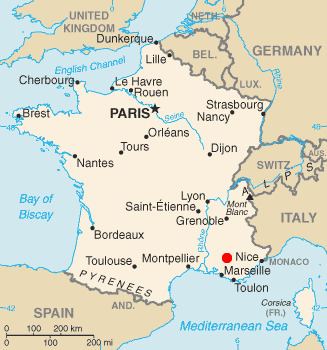Local time Monday 2:04 AM | Phone +33 4 42 25 70 00 | |
 | ||
Weather 6°C, Wind W at 8 km/h, 94% Humidity Hours Open today · 8:30AM–5PMMonday8:30AM–5PMTuesday8:30AM–5PMWednesday8:30AM–5PMThursday8:30AM–5PMFriday8:30AM–5PMSaturdayClosedSundayClosed | ||
The Cadarache facility is a French scientific research centre which specialises in nuclear power research. It is located in the commune of Saint-Paul-lès-Durance, Bouches-du-Rhône, in the southern region of Provence-Alpes-Côte-d'Azur. Located approximately 60 kilometres (37 mi) north-east of the city of Marseille, Cadarache has been a nuclear research centre since President Charles de Gaulle launched France's atomic energy program in 1959. The centre is operated by the Commissariat à l'Énergie Atomique (CEA, en: Atomic Energy Commission).
Contents
- Incident au centre de cadarache archive vid o ina
- Facilities
- Activities
- Notable incidents
- Seismological risk
- References
In 2005, Cadarache was selected to be the site of the International Thermonuclear Experimental Reactor (ITER), the world's largest nuclear fusion reactor. Construction of the ITER complex began in 2007, and it is projected to begin plasma-generating operations in the 2020s. Cadarache also plays host to a number of research reactors, such as the Jules Horowitz Reactor, which is expected to enter operation around 2016.
Incident au centre de cadarache archive vid o ina
Facilities
The Cadarache facility is one of the largest nuclear research sites in Europe, hosting 21 fixed nuclear installations, including reactors, waste stockpiling and recycling facilities, and research centers. It employs over 4,500 people, and approximately 350 students and foreign collaborators carry out research in the facility’s laboratories.
One of the most notable nuclear installations at Cadarache is the ITER experimental nuclear fusion tokamak, which is expected to be completed by 2020. When it becomes operational in the mid-to-late 2020s, ITER is hoped to be the first large-scale fusion reactor to produce more energy than is used to initiate its fusion reactions. Other nuclear installations at Cadarache include the Tore Supra tokamak – a predecessor to ITER – and the Jules Horowitz Reactor, a 100-megawatt research reactor which is planned to begin operation in 2016.
Activities
Numerous nuclear research activities are conducted at Cadarache, including mixed-oxide fuel (MOX) production, nuclear propulsion and fission reactor prototyping, nuclear fusion research and research into new forms of fission fuel. Nuclear waste is also treated and recycled at the site.
Notable incidents
A number of accidents, of varying severity, have occurred at Cadarache since its inception. Some of these incidents are listed below.
Seismological risk
Cadarache is situated on the Aix-en-Provence-Durance seismological fault, and lies close to another fault, Trévaresse. The Aix-Durance fault caused France's worst recorded earthquake in 1909. In a 2000 report, the ASN mandated the closure of six installations at Cadarache that did not meet aseismic construction standards; a similar report was issued by a French nuclear safety organisation in 1994. By 2010, three of these had been shut down, with the remaining three to be shut down by 2015.
